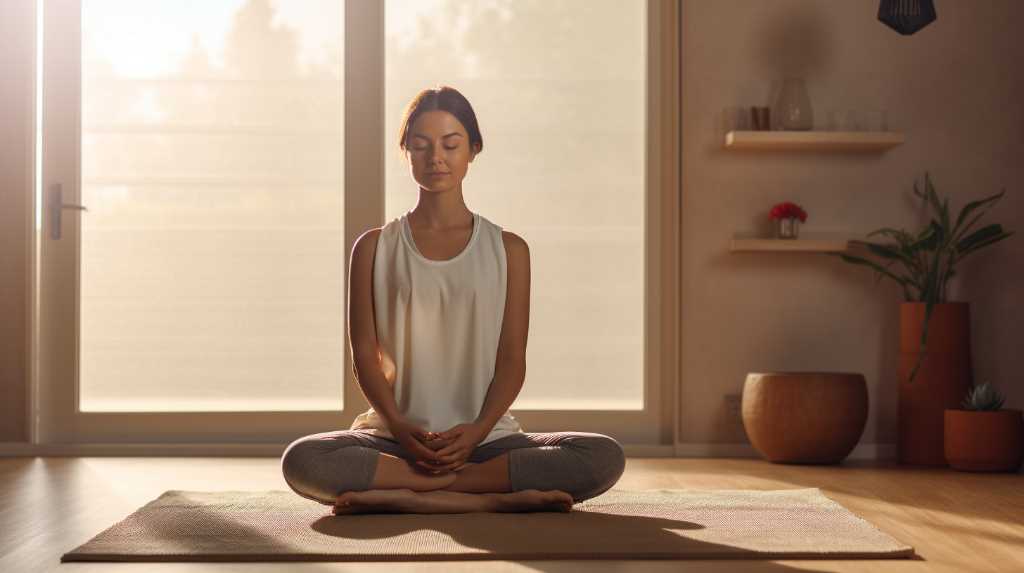Ever feel like your mind’s running a marathon with no finish line? You’re not alone. Let’s break it down together, starting with the simplest of daily meditation routines.
Here, you’ll learn the essentials, set up a space that’s uniquely yours, and find a rhythm that fits your life.
Breathe in ease, breathe out stress, and discover whether guided or unguided sessions speak to you.
Embrace the hiccups along the way—you’re on a journey to a more mindful you.
Key Takeaways
- Meditation requires awareness and being present with thoughts and external noises.
- There is no ‘right’ way to meditate; it’s a personal journey.
- Diaphragmatic breathing enhances relaxation and focus.
- Find a consistent time slot that fits your existing schedule.
Understanding Meditation Basics
Before diving into your new daily meditation routine, it’s essential to grasp the fundamental principles that underpin this practice. Let’s gently dispel some meditation myths that might be clouding your perception.
You might think that meditation requires an empty mind or a perfectly serene environment, but that’s not the case. Meditation is about awareness and being present with whatever is happening within you, even if that includes a whirlwind of thoughts or external noises.
Remember, there’s no ‘right’ way to meditate that applies to everyone. You’re embarking on a personal journey, and it’s okay to start where you are, using tools that suit your needs. Mindfulness apps can be a great ally in this process, offering guided sessions that help you find your footing.
Don’t worry if your mind wanders or if you can’t sit still for long periods; it’s all part of the learning curve. Embrace the process with kindness towards yourself, and observe the sensations and thoughts without judgment.
With time and practice, you’ll find your rhythm and discover what works best for you. So, take a deep breath, find a comfy spot, and let’s begin this journey together.
Setting Up Your Space
Creating a serene meditation space is crucial for your practice. You’ll want to find a seat that supports your posture and allows you to relax fully.
Remember to clear away clutter and silence any devices that might interrupt your focus.
Choose Comfortable Seating
Selecting a cushion or chair that supports your posture is crucial in establishing a conducive space for your meditation practice. Posture importance can’t be overstated; it’s the foundation that determines your comfort and concentration. Cushion choices vary, so find one that keeps your spine aligned without straining.
Comfort Considerations:
- Ensure it’s the right height to keep your knees lower than your hips.
- Opt for a firm cushion that doesn’t collapse under your weight.
Remember, your space should invite peace and focus. Arrange it to minimize distractions and maximize comfort. As you settle into your seat, let go of the day’s stress. This is your time—a sacred pause in your bustling world.
Take a deep breath and begin your journey inward.
Minimize Distractions
Every element in your chosen meditation area should serve to reduce interruptions, allowing you to fully immerse yourself in the practice.
Start by selecting a quiet corner that feels serene to you—somewhere you can be undisturbed, especially if meditation is part of your morning routine.
Consider using focus music or nature sounds to mask background noise; soft, ambient playlists can encourage a deeper state of relaxation and concentration.
Keep the space tidy and inviting, with minimal clutter. A clean environment helps clear the mind and makes it easier to let go of external concerns.
As you prepare to meditate each day, remember that this is your time to reconnect with yourself, undistracted.
Next, let’s explore how to weave this tranquil practice into establishing a daily schedule.
Establishing a Daily Schedule
To establish a daily meditation routine, you’ll need to carve out a consistent time slot that fits seamlessly into your existing schedule. Integrating meditation into your morning routine can set a tranquil tone for the day, while an evening wind down session may help you let go of daily stresses. Consider these steps:
- Find Your Moment
- Morning Routine
- Wake up a little earlier to meditate and start your day with clarity.
- Link meditation to your first cup of coffee or tea for a mindful awakening.
- Evening Wind Down
- Meditate before dinner to transition from work to personal time.
- Create a nighttime ritual by meditating before bed for restful sleep.
Remember, the goal is consistency, not perfection. Be gentle with yourself as you find the rhythm that works for you. If you miss a day, simply resume the next. Meditation is your personal retreat, a moment of peace in the hustle of life.
With your schedule set, you’re ready to dive into the essence of your practice. In the next section, we’ll explore ‘breathing techniques explained’, where you’ll learn how to use your breath as a powerful tool to enhance your meditation experience.
Breathing Techniques Explained
As you settle into your new meditation routine, let’s gently explore the core of your practice: breathing.
Diaphragmatic breathing is a powerful technique that can enhance your relaxation and focus; it’s about breathing deeply into your belly, allowing your diaphragm to do the work.
We’ll also guide you through the counted breath practice, a method that helps pace your breaths and brings a soothing rhythm to your meditation.
Diaphragmatic Breathing Benefits
Diaphragmatic breathing, or deep abdominal breathing, enhances your meditation routine by reducing stress and improving focus. This technique is fundamental to eliciting the relaxation response, a state where stress management becomes second nature to you. Here’s how you can reap its benefits:
- Relaxation Response
- Activates calming pathways in your nervous system
- Reduces the impact of stress on your body
- Stress Management
- Enhances your ability to cope with daily pressures
- Improves overall emotional regulation
As you practice, you’ll notice a gentle rise and fall of your abdomen, which signals that you’re on the right track. It’s your body’s way of saying, ‘You’ve got this.’
Counted Breath Practice
Building on your diaphragmatic breathing skills, you’ll find that integrating a simple counted breath practice can significantly enhance your meditation routine. You’ll begin by gently inhaling through your nose, mentally counting to four. Hold that breath for a count of four, then smoothly exhale through your mouth for another count of four.
This rhythm, known as breath synchronization, creates a soothing cycle that anchors your focus.
As you become comfortable, you might introduce mantra incorporation. Pair your breaths with a calming phrase or sound, repeating it silently with each cycle. This can deepen the meditative experience, aligning your mind and breath in tranquil harmony.
Guided Vs. Unguided Sessions
In choosing between guided and unguided meditation, you’ll find each has unique advantages that cater to different preferences in your journey toward mindfulness. If you’re starting out, guided sessions can be a comforting hand to hold. Meditation apps are a great resource, offering a variety of guided experiences with gentle instructions and music selection that resonates with your mood and needs.
- Guided Meditation
- Meditation Apps: Easy to use; vast library of sessions
- Music Selection: Tailored playlists to enhance your experience
Conversely, unguided meditation allows you to delve into silence or create your own ambiance. It’s a space where you’re the sole guide, listening to the rhythm of your breath and the beat of your heart.
- Unguided Meditation
- Personal Pace: Move at your own rhythm without external guidance
- Self-Exploration: Encourages a deeper connection with your inner self
Remember, there’s no right or wrong here. It’s about what feels most natural to you, allowing you to cultivate a practice that you’ll stick with. As you grow more comfortable, you might find yourself gravitating toward one style or even blending the two.
As you become accustomed to the stillness and the flow of your thoughts, you’ll likely face some hurdles. Let’s explore how to overcome common challenges in the next section.
Overcoming Common Challenges
As you settle into your meditation practice, you’ll likely encounter distractions and discomfort, common hurdles that can be navigated with a few practical strategies. First, let’s dispel some meditation myths that might be holding you back. You don’t need to empty your mind completely or sit for hours to reap the benefits. Meditation is about presence, not perfection.
Personal obstacles will arise, such as nagging thoughts or physical restlessness. When they do, acknowledge them without judgment and gently redirect your focus to your breath or chosen point of attention. It’s okay if it happens repeatedly; it’s part of the process.
Remember, discomfort is temporary. If you’re struggling to find a comfortable position, use cushions or a chair to support your posture. The aim is to be steady and at ease.
If external noises distract you, consider them part of the ambient soundscape rather than intrusions. Over time, your ability to remain undisturbed will strengthen. With consistent practice, these challenges will become less daunting, and you’ll find your rhythm.
Keep it simple, be patient with yourself, and embrace the journey. Your meditation practice is a personal exploration, one that grows richer with each session.
Tracking Progress Mindfully
You’ll notice your meditation practice deepening as you track your progress with mindful attention to the subtle shifts in your daily sessions. It’s about acknowledging the journey without judgment, and celebrating each small victory.
Mindfulness apps can offer structure and reminders to keep you engaged, while journal reflections provide a space for personal insight.
- Mindfulness Apps
- Structure: They offer a variety of guided meditations and tracking features to help you stay on course.
- Reminders: Set gentle nudges for daily practice and reflect on your streaks and patterns.
- Journal Reflections
- Personal Insight: Writing down your thoughts post-meditation can reveal inner changes and growth.
- Non-Judgmental Awareness: Observe your feelings and experiences without self-criticism.
Remember, there’s no right or wrong way to meditate. Every moment of mindfulness counts. Whether you’re using an app to guide you or writing reflective journal entries, you’re paving the way to a more present and peaceful you.
Take pride in your commitment to self-improvement, and continue to approach each day with an open heart and mind.
What are the Benefits of Daily Meditation Routines for Newbies?
For newbies, understanding the daily meditation habits importance is crucial. By incorporating a daily meditation routine, beginners can experience reduced stress, improved focus, and increased overall well-being. These habits can also help in enhancing self-awareness, promoting emotional health, and cultivating a more positive outlook on life.
FInal Thoughts
You’ve gracefully danced through the basics, carved out a serene corner, and nestled a new rhythm into your days.
Breathing life into each moment, you’ve explored the gentle guidance of a mentor and the quiet paths of solitude.
When bumps in the road appear, remember, they’re merely stepping stones to your serenity.
Cherish the unfolding journey within and celebrate each whisper of progress in your soul’s tranquil diary.
Keep glowing on this serene voyage.




